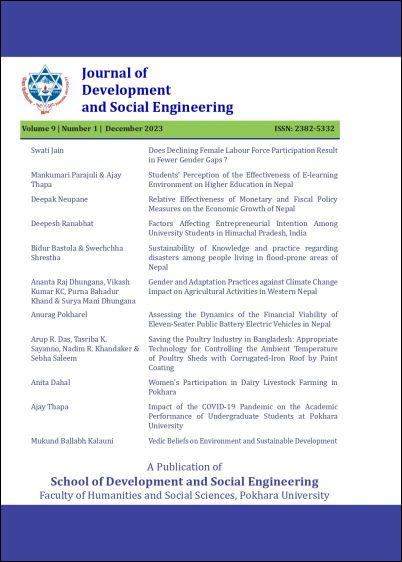Saving the Poultry Industry in Bangladesh: Appropriate Technology for Controlling the Ambient Temperature of Poultry Sheds with Corrugated-Iron Roof by Paint Coating
DOI:
https://doi.org/10.3126/jdse.v9i01.70609Keywords:
global warming, poultry industry, thermal mitigation, red rust-proof paintinsAbstract
Bangladesh experienced a significant rise in temperature over the past years which has affected a 3 billion USD poultry industry due to an increased mortality rate of poultry. Global warming has resulted in increasing indoor temperature of the poultry sheds throughout the day as the sheds are made of corrugated iron sheets that absorb infrared radiation that exacerbates ambient shed temperature. An experimental program was conducted that looked at painting the corrugated iron sheets to limit the sunlight inferred energy transferred, thus, decreasing the temperature in the poultry sheds. Sets of corrugated iron sheets were chosen: unpainted as a reference, red rust proof, and white enamel paint coating, with identical dimensions and thickness. The experiment was conducted under sunlight and the top and bottom surface temperatures of the corrugated iron sheets were recorded using an inferred sensor at predetermined intervals. Multiple runs were for more accurate and precise results. Heat accumulation was significantly reduced by coating corrugated-iron sheets with red rust-proofing (corrugated-iron sheet bottom surface temperatures; red rust proof 83.5 ± 3.6 < White 85.4 ± 4.6 < unpainted 88.3 ± 4.9). The combined effect would be that the internal temperature of the poultry sheds would be reduced by painting the corrugated-iron roofs red rust-proof coating. Painting the poultry sheds with red rust-proof paint could be a viable mitigation measure to sustain the poultry farms in Bangladesh amidst warming temperatures - an appropriate technology solution bolstered by the local supply chain.
Downloads
Downloads
Published
How to Cite
Issue
Section
License
Copyright © Journal of Development and Social Engineering, School of Development and Social Engineering, Faculty of Humanities and Social Sciences, Pokhara University. All rights reserved. The School of Development and Social Engineering, Pokhara University holds the exclusive copyright of all the contents of this journal. No part of this journal may be reproduced or transmitted by any media or publishing organizations including websites without the written permission of the copyright holder. The contents of this journal are available for any citation, using a recognized and proper referencing system.




